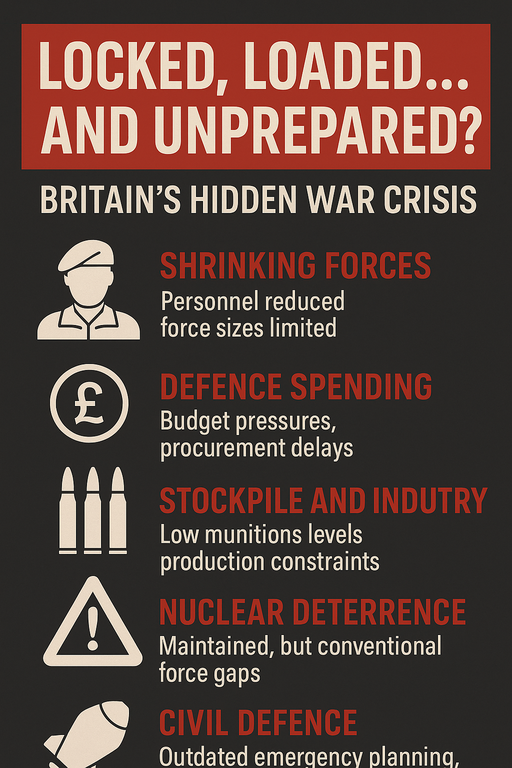Modern threats meet ageing systems—can Britain really fight a 21st-century war?
Amid rising global instability from Eastern Europe to the Indo-Pacific questions about Britain’s true military readiness are gaining urgency. On the surface, the United Kingdom appears well-armed and aligned with powerful allies. But beneath this outward strength lies a troubling reality: shrinking force sizes, logistical bottlenecks, and critical vulnerabilities. Is Britain genuinely prepared for a modern war, or dangerously overconfident?
A Force Shrinking in Silence
The British Armed Forces have been steadily reduced in size over the past two decades:
- Personnel: Just 137,000 regulars remain across the Army, Navy, and RAF, with 30,000 reservists—a sharp decline from Cold War levels.
- British Army: Cut to around 72,000 soldiers, well below NATO averages for major powers.
- Royal Navy and RAF: Equipped with high-tech platforms like aircraft carriers and F-35 jets, but constrained by manpower and maintenance delays.
Officials argue these reductions reflect a shift to “leaner, smarter” forces. Critics say they risk hollowing out core capabilities.
Money Matters—But May Not Be Enough
Britain spends heavily on defence—£56 billion in 2024, meeting NATO’s 2% GDP benchmark. But:
- Inflation and rising costs dilute real spending power.
- Procurement delays plague key programs like Ajax armoured vehicles and Type 26 frigates.
- Nuclear deterrence (via the Trident submarine fleet) remains a budget priority, but some argue it comes at the cost of conventional forces.
The government has pledged to raise spending to 2.5% of GDP “when fiscal conditions allow,” but critics warn that may be too late.
Source: defence spending.pdf
Stockpiles and Industry: A Quiet Crisis
Britain’s ability to sustain war over time is constrained by limited industrial capacity:
- Ammunition stockpiles have been drawn down by support for Ukraine, leaving gaps in readiness.
- Munitions production is currently too slow for a high-intensity conflict.
- Defence industry faces long lead times and supply chain risks, especially for complex weapons systems.
While new factories and investments are underway, full-scale war readiness would require years not months of build-up.
The Nuclear Shield—Or Strategic Mirage?
The UK’s Trident program provides a continuous at-sea nuclear deterrent. But:
- Its effectiveness is primarily for strategic deterrence—not conventional combat.
- Replacement submarines (the Dreadnought class) won’t enter service until the 2030s.
- Critics argue nuclear deterrence cannot substitute for underfunded conventional forces.
The shield is there—but Britain’s sword may be duller than it appears.
5. Allies as a Lifeline
Britain’s strategic weight is amplified through alliances:
- NATO ensures collective defence, with UK troops stationed in Eastern Europe.
- AUKUS and Five Eyes partnerships boost intelligence and technological collaboration.
- US and EU support is vital in any major conflict scenario.
But heavy reliance on allies raises concerns about national autonomy and the UK’s ability to operate independently under duress.
Civil Defence: The Forgotten Front
Perhaps the most under-discussed element of preparedness is the civilian side:
- Emergency planning for infrastructure, cyberattacks, and logistics is outdated.
- Public awareness of wartime contingencies is virtually nonexistent.
- Resilience against hybrid threats—like cyberwarfare or economic disruption—is still developing.
A modern war would hit far beyond battlefields. The UK’s home front may not be ready.
Conclusion: Strength or Illusion?
Britain maintains formidable assets: elite troops, nuclear deterrence, and advanced technology. But without greater investment in manpower, munitions, and logistics, the country may struggle in a prolonged, high-intensity war.
The UK is locked and loaded—but in a world of hypersonic missiles, cyber sabotage, and proxy conflicts, it may not be fully prepared. What’s needed isn’t just bigger budgets, but a full-spectrum rethink of what war in the 21st century truly demands.














Leave a Reply